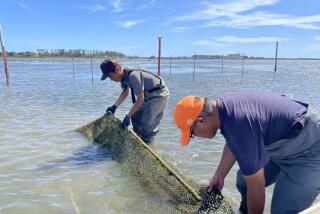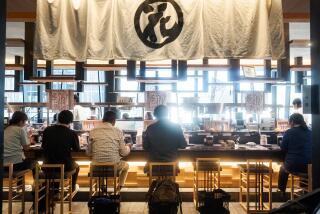Ivory Ban Hurts Japan’s Carving Trade
- Share via
ROKUGO, Japan — Japan’s ban on ivory imports may help save the African elephant, but ivory artisans believe that it may mean the end of the centuries-old industry of carving Japanese signature seals.
The price of ivory, up sixfold at the wholesale level, began to rise long before delegates gathered in October at the Convention on International Trade in Endangered Species to ban the trade, said Akitoshi Kobayashi, a 69-year-old master carver.
For Japan’s ivory workers, the ban will mean a drop in income, said Kobayashi, who has been in the trade for more than 50 years in Rokugo, a town near Mt. Fuji that is a center of ivory carving.
Carving name seals, called hanko , is profitable because about 80% are made from ivory, which costs more to carve than other materials.
At the Mitsukoshi Department Store in Tokyo, the price of a seal little more than half an inch in diameter has increased 11.5%, to the yen equivalent of about $253, since the spring of 1989.
In Japan, signatures have little importance, and name seals are legal marks of identification. The hanko seals are shaped like lipstick cases and have the owner’s name engraved at one end in Chinese characters, which the Japanese use to write their language.
Official documents must be affixed with the name seal, which also is needed to open a bank account. A check without the seal is invalid.
Japan joined the international ban on ivory trade just as Rokugo’s basic industry started to climb out of a 15-year slump, said Kobayashi, who heads Rokugo’s Council for Promotion of Seal Businesses.
“We did everything possible to prevent an import ban of ivory from going into effect,” he added. “Now that the ban is decided, nothing can be done about it. The industry will have many difficulties on the way ahead.”
“It’s a sort of Japan-bashing because Japanese buyers raise prices of ivory tusks on the market,” said another artisan, Kenzo Takii, who works in Kofu, north of Rokugo.
Takii, who has traveled to Africa seven times to buy ivory tusks, says he feels very uncertain about the future.
Rokugo, a mountain town of about 4,800 people, is known as the hometown of hanko seals because about half of them are carved there, according to town official Masafumi Mochizuki.
About 360 townspeople are engaged in the seal business. Most ivory-carving workshops are small, family enterprises.
Last year, the town made about $14 million selling name seals and related products, Mochizuki said.
In 1988, Japan imported 106 tons of unprocessed ivory and 26 tons of finished ivory, according to the Ministry of International Trade and Industry. About 53% was used for seals, according to the conservation group Traffic (Japan).
It was rumored that dealers, fearing a ban on imports, stockpiled about 100 tons of ivory, enough for the next year or two.
To survive, Kobayashi said, the industry is looking for a substitute for ivory.
Water buffalo horns, boxwood, crystal and onyx are used. However, “Nothing is better than ivory,” Kobayashi said.
“Ivory meets all the conditions as a material for hanko, “ he said. “It’s beautiful to look at. You can engrave ivory easily and beautifully.”
But a Mitsukoshi sales clerk said consumers’ tastes are quietly changing, apparently in response to the ivory-imports ban. He said some prefer seals made of the horns of water buffalo and boxwood.
The industry tried using horns of sheep from the high mountains of China and Tibet, but found them unsatisfactory.
They even experimented with tusks from the prehistoric mammoth, which Soviet dealers in Siberia sell for hard currency. Kobayashi said the quality matched that of African elephants but only the center of a tusk can be used, making it about twice as expensive as ivory.
Several Japanese companies are encouraging ivory carvers to use platinum or gold, which would force carvers to invest in expensive machines.
More to Read
Sign up for Essential California
The most important California stories and recommendations in your inbox every morning.
You may occasionally receive promotional content from the Los Angeles Times.













